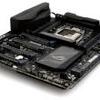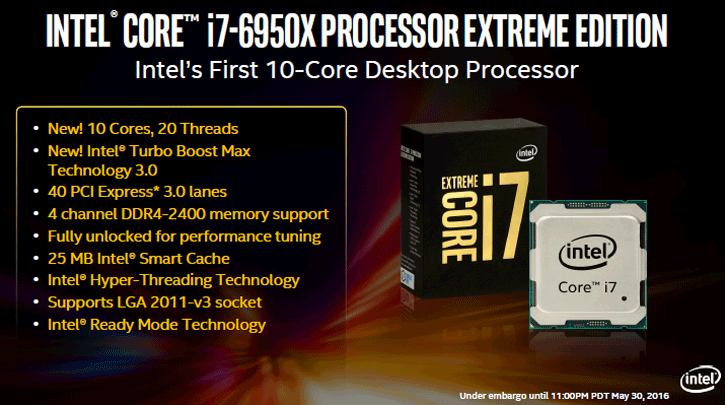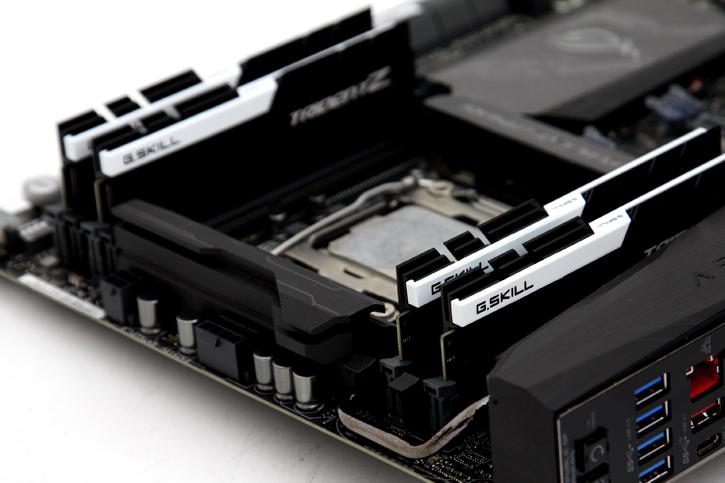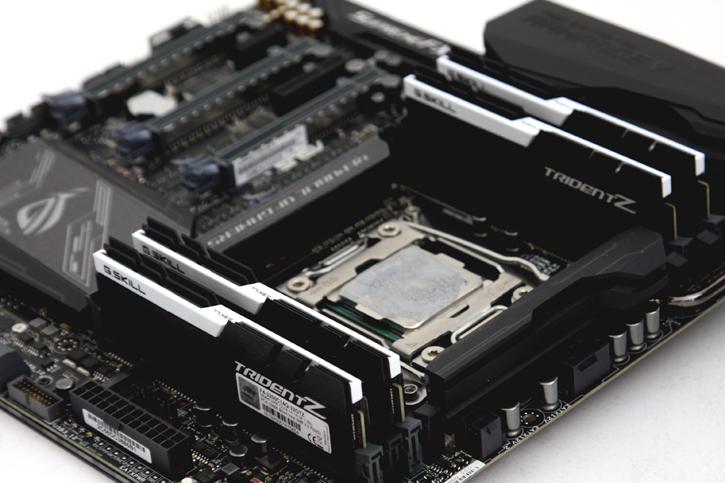The Intel X99 PCH
DDR4 System Memory
Starting with Haswell-E and now following with Broadwell-E, with the X99 chipset Intel made a move towards DDR4 memory. Intel will support JEDEC timed DDR4 DIMMs in steps of 1,333 MHz, 1,600 MHz, 1,866 MHz, 2,133 MHz and now 2,400 MHz. DDR4 right now offers better timings starting in the CL 14/15 range and has become much cheaper. You notice that default DDR4 system memory only needs 1.2 Volts, whereas DDR3 starts at 1.5 Volts. Even the OC modules at 3.2 GHz these days can run at only 1.30 Volts.
Have no fear, as many memory partners will release DDR4 memory at even higher clock frequencies and, over time, lower latencies. The modules will be low voltage (1.2 V) DDR4 RAM. The DIMM connector now has 288 pins (as opposed to 284 from earlier). Most kits, if not all, will be Intel XMP 2.0 (Extreme Memory Profile) enabled and are guaranteed to work with motherboard partners like ASUS, ASRock, Gigabyte and MSI. With XMP memory you simply enable XMP in the System BIOS, and your memory will be pre-configured on the highest supported clock frequency, timings and voltage to ensure best performance versus maximum stability.
Quad-Channel Memory
One of the more hip features of the X99 platform is the ability to use quad-channel memory. Back in 2008 we already reported that the initial Nehalem architecture was quad-channel ready, they just had never implemented it up-to X79. Intel's 64-bit memory controllers rock hard and a lot certainly happened. Over the space of a couple of years we went from dual-channel towards triple-channel on X58 (Gulftown), then back to dual-channel with the Sandy/Ivy Bridge/Haswell architecture and with Haswell-E we get quad-channel memory support, this round with DDR4 memory.
Admittedly, the Intel memory controller, whatever platform you choose, is super fast. Sandy & Ivy Bridge, Haswell, Broadwell and Skylake and its dual-channel controllers already haul that proverbial tooshy, make no mistake there. At launch, for Broadwell-E quad-channel 2,133/2,400 MHz low-voltage DDR4 is supported out of the box, and that means an increase to 68 GB/s of available memory bandwidth depending on timings and latency of course. Quad-channel is fun stuff, crazy numbers is what you'll see. What the effect will be on real-world performance is trivial at best.
PCIe Gen 3.0
Fully supported is the inclusion of PCI Express Gen 3. In a nutshell, PCI Express Gen 3 provides a 2X faster transfer rate than the previous generation, this delivers capabilities for next generation extreme gaming solutions. PCI Express Gen 3 has twice the available bandwidth, 32 GB/s, improved efficiency and compatibility and as such it will offer better performance for current and next gen PCI Express cards. Going from PCIe Gen 2 to Gen 3 doubles the bandwidth available to the add-on cards installed, from 500 MB/s per lane to 1 GB/s per PCI Express lane. So a Gen 3 PCI Express x16 slot is capable of offering 16 GB/s (or 128 Gbps) of bandwidth in each direction. That results in 32 GB/sec bi-directional bandwidth.
PCIe Lanes
The one thing that people grumble about the most is the relatively small number of available PCIe lanes (16) for graphics cards. If you are using a setup with two or more graphics cards (SLI/Crossfire), the PCIe bandwidth is limited at x8:x8. Here again the performance difference is trivial as running today's fastest cards barely utilizes all that bandwidth, but two x16 and then room for another x8 obviously is much better.
- The ten core Core i7 6950X has 40 lanes (PCIe Gen 3.0) available.
- The eight core Core i7 6900K has 40 lanes (PCIe Gen 3.0) available.
- The six core Core i7 6850K has 40 lanes (PCIe Gen 3.0) available.
- The six core Core i7 6800K has 28 lanes (PCIe Gen 3.0) available.
You can split them up in a variety of combinations, two x16 links with one x8 link, one x16 link and three x8 links, or one x16 link, two x8 links, and two x4 links. So, some examples; Intel Core i7-6950X and Intel Core i7-6850K would support multiple graphics card configurations with the first two cards running at x16 speed and say a third one running at x8 speed. Meanwhile a Core i7-6800K would only support 1 x16 + 1 x8 + 1 x4 multiple graphics card configurations. Again, all are Gen 3.0 so really that is a lot (read plenty) of bandwidth.
LGA 2011-V3
Years ago we left LGA 775 then started with LGA 1366, then moved to LGA 1156, with Sandy and Ivy Bridge we moved to LGA 1155, Skylake LGA 1151 and Haswell had Socket 1150. Still with me? Broadwell-E just like Haswell-E stuck to socket LGA 2011-V3, if you finally are about to upgrade to X99 you can use the same cooler you used on your X79 motherboard for example, as long as it can deal with the 140 Watt TDP/Heat output of the processor.
Most LGA 2011 coolers will be perfectly compatible. Now though, Broadwell-E/Haswell-E uses the latest iteration of that older LGA 2011 socket. Tagged as LGA 2011-V3, the socket has the same dimensions and ball pattern pitch as LGA 2011. Even the number of pins remains the same. However, the processors are not backwards compatible. So Broadwell-E and Haswell-E need to be seated on LGA 2011-V3 and do not work on X79. Neither does the new socket support older generation processors.




